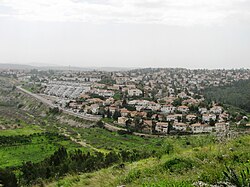Oranit: Difference between revisions
add |
add |
||
| Line 37: | Line 37: | ||
}}</ref> |
}}</ref> |
||
In 1985, the first residents moved in. In 1990, Oranit achieved local council status. In 2009, Israeli prime minister [[Benjamin Netanyahu]] imposed a 10-month freeze on construction in Oranit and other Israeli settlements in the West Bank.<ref>[http://www.miftah.org/Doc/Articles/2009/Dec02MHD2k9.html Miftah ]</ref> |
In 1985, the first residents moved in. In 1990, Oranit achieved local council status. In 2009, Israeli prime minister [[Benjamin Netanyahu]] imposed a 10-month freeze on construction in Oranit and other Israeli settlements in the West Bank.<ref>[http://www.miftah.org/Doc/Articles/2009/Dec02MHD2k9.html Miftah ]</ref> Building inspectors of the Israeli military's civil administration issued a stop-work order, sending home a crew of Palestinian laborers who had been employed at a building site in Oranit.<ref>[http://www.csmonitor.com/World/Middle-East/2009/1201/p06s11-wome.html In Israeli settlements, residents and builders push back on 10-month freeze]</ref> |
||
==Demographics== |
==Demographics== |
||
Revision as of 09:25, 28 May 2012
Template:Infobox Israel municipality Oranit (Template:Lang-he-n) is an Israeli settlement and local council located in the Seam Zone, straddling the Green Line. It is surrounded by Horshim forest to the west, Rosh HaAyin and Kfar Qasim to the southwest, Sha'arei Tikva to the east, and Abu Salman to the northeast. In 2009, the population was over 6000.[1]
The international community considers Israeli settlements in the West Bank illegal under international law, but the Israeli government disputes this.[2]
History
In April 1983, the Israeli government approved the establishment of Oranit, one of three settlements planned for "western Samaria." [3]According to the UN Relief and Works Agency for Palestine Refugees in the Near East 3,000 dunums of Palestinian land were expropriated to make way for the establishment of Oranit. Thirty Palestinian farmers were initially given access to their farmland through the the gates of the settlement. This right was later withdrawn for security reasons.[4]
In 1985, the first residents moved in. In 1990, Oranit achieved local council status. In 2009, Israeli prime minister Benjamin Netanyahu imposed a 10-month freeze on construction in Oranit and other Israeli settlements in the West Bank.[5] Building inspectors of the Israeli military's civil administration issued a stop-work order, sending home a crew of Palestinian laborers who had been employed at a building site in Oranit.[6]
Demographics

According to the 2009 survey, around 20% of the population is aged 0-9, 10-19, 30-44, 45-59 respectively. 10% is aged 20-29, and 10% is aged 60 and over. There is an equal split between the number of women and men. Around 15% of the community is orthodox, two-thirds of whom live in the religious neigbourhood. Oranit is ranked 7 out of 10 on the Israeli socio-economic scale.[7]
Economy
Most residents work outside Oranit. In 2007, the average salary was NIS 5,762 per month compared to a national average of NIS 6,324.
Transportation and services
Access by road is via Highway 5. There is an infrequent bus service to and from nearby Petach Tikva and Ariel. The town contains a small commercial centre including a supermarket, coffee shops, bank, health-care facilities and a post office.
Education
There is an elementary school, a middle school, and some children from the town attend other schools in the wider area. Another elementary school is planned.
71% of twelfth-grade pupils passed the Bagrut matriculation certificate in 2005/06.
References
- ^ "Table 3 - Population of Localities Numbering Above 1,000 Residents and Other Rural Population" (PDF). Israel Central Bureau of Statistics. 2007-12-31. Retrieved 2008-06-23.
- ^ "The Geneva Convention". BBC News. 10 December 2009. Retrieved 27 September 2011.
- ^ Encyclopedia of the Palestine Problem
- ^ "Impact of the First Phase of the Security Barrier on the Qalqiliya, Tulkarmand Jenin districts". United Nations Relief and Works Agency for Palestine Refugees in the Near East. 1 July 2003. Retrieved 27 May 2012.
- ^ Miftah
- ^ In Israeli settlements, residents and builders push back on 10-month freeze
- ^ "Local Authorities in Israel 2009, Publication #1451 - Municipality Profiles - Oranit" (PDF). Israel Central Bureau of Statistics. Retrieved 2011-09-7.
{{cite web}}: Check date values in:|accessdate=(help)Template:He icon
